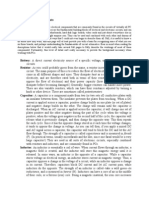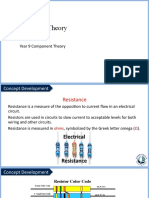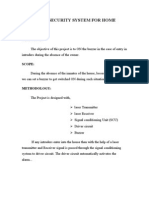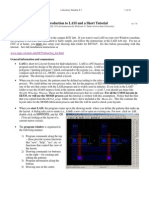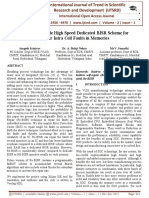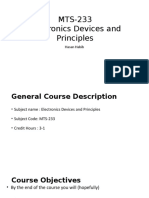Laser Communication
Laser Communication
Uploaded by
Neel VaniyaCopyright:
Available Formats
Laser Communication
Laser Communication
Uploaded by
Neel VaniyaOriginal Title
Copyright
Available Formats
Share this document
Did you find this document useful?
Is this content inappropriate?
Copyright:
Available Formats
Laser Communication
Laser Communication
Uploaded by
Neel VaniyaCopyright:
Available Formats
www.btechworld.
com
LASER BASED VOICE TRANSMITTER & RECEIVER
BY CH.SABARINADH, 09MD1A0472, IInD ECE, Sabarinadh007@gmail.com 8125775576. K. S.RAHUL 09MD1A0496, IInd ECE, rahulkunche50@gmail.com SRINIVAS 10MDLE407, IInd ECE,
INDEX
Sr. No.
1. 2. 3. 4. 5. 6. 7. 8.
Contents
Certificate of Completion Acknowledgement Preface Introduction; Laser based Voice Transmitter and Receiver Electronic Components Leads Identification BC 546 BC 548
Page No.
1 2 4-5 6-12 13-14 15-17 18-19
www.btechworld.com 1
www.btechworld.com
9. 10. 11. 12. 13.
UA 741 SL 100 LM 386 L14F1 Conclusion
20-22 23-24 25-27 28-29 30
LASER TORCH-BASED VOICE TRANSMITTER AND RECEIVER
Using this circuit you can communicate with your neighbors wirelessly. Instead of RF signals, light from a laser torch is used as the carrier in the circuit. The laser torch can transmit light up to a distance of about 500 meters. The phototransistor of the receiver must be accurately oriented towards the laser beam from the torch. If there is any obstruction in the path of the laser beam, no sound will be heard from the receiver. The transmitter circuit (Fig. 1) comprises condenser microphone transistor amplifier BC548 (T1) followed by an pomp stage built around A741 (IC1). The gain of the op-amp can be controlled with the help of 1-mega-ohm potmeter VR1.The AF output from IC1 is coupled to the base of transistor BD139 (T2), which, in
www.btechworld.com 1
www.btechworld.com
turn,
modulates
the
laser
beam.
The transmitter uses 9V power supply. However, the 3-volt laser torch (after removal of its battery) can be directly connected to the circuitwith the body of The torch connected to the emitter ofBD139 and the spring-loaded lead protruding from inside the torch to circuit ground. The receiver circuit (Fig. 2) uses an npn phototransistor as the light sensor that is followed by a two-stage transistor preamplifier and LM386-based audio Power amplifier. The receiver does not need any complicated alignment. Just keep the phototransistor oriented towards the remote transmitters laser point and adjust The volume control for a clear sound. To avoid 50Hz hum noise in the speaker, keep the phototransistor away from AC light sources such as bulbs. The reflected sunlight, however, does not cause any problem. But the sensor should not directly face the sun.
www.btechworld.com 1
www.btechworld.com
A BRIEF SUMMARY OF COMPONENTS USED
When a beginner to electronics first looks at a circuit board full of components he/she is often overwhelmed by the diversity of do-dads. In these next few sections we will help you to identify some of the simple components and their schematical symbol. Then you should be able to call them resistors and transistors instead of Whatchamacallits. Electronic component are classed into either being Passive devices Or Active devices.
www.btechworld.com 1
www.btechworld.com
A Passive Device is one that contributes no power gain (amplification) to a circuit or system. It has not control action and does not require any input other than a signal to perform its function. In other words, A components with no brains! Examples are Resistors, Capactitors and Inductors Active Devices are components that are capable of controlling voltages or currents and can create a switching action in the circuit. In other words, Devices with smarts! Examples are Diodes, Transistors and Integrated circuits. Most active components are semiconductors.
Resistors:
This is the most common component in electronics. It is used mainly to control current and voltage within the circuit. You can identify a simple resistor by its simple cigar shape with a wire lead coming out of each end. It uses a system of color coded bands to identify the value of the component (measured in Ohms) *A surface mount resistor is in fact mere millimeters in size but performs the same function as its bigger brother, the simple resistor. A potentiometer is a variable resistor. It lets you vary the resistance with a dial or sliding control in order to alter current or voltage on the fly. This is opposed to the fixed simple resistors.
Condensers/Capacitors:
Capacitors, or "caps", vary in size and shape - from a small surface mount model up to a huge electric motor cap the size of a paint can. It storages electrical energy in the form of electrostatic charge. The size of a capacitor generally determines how much charge it can store. A small surface mount or ceramic cap will only hold a minuscule charge. A cylindrical electrolytic cap will store a much larger charge. Some of the large electrolytic caps can store enough charge to kill a person. Another type, called Tantalum Capacitors, store a larger charge in a
www.btechworld.com 1
www.btechworld.com
smaller package.
Inductors:
You may remember from science class that adding electrical current to a coil of wire produces a magnetic field around itself. This is how the inductor works. It is charged with a magnetic field and when that field collapses it produces current in the opposite direction. Inductors are used in Alternating Current circuits to oppose changes in the existing current. Most inductors can be identified by the "coil" appearance. Others actually look like a resistor but are usually green in color.
Diodes:
Diodes are basically a one-way valve for electrical current. They let it flow in one direction (from positive to negative) and not in the other direction. This is used to perform rectification or conversion of AC current to DC by clipping off the negative portion of a AC waveform. The diode terminals are cathode and anode and the arrow inside the diode symbol points towards the cathode, indicating current flow in that direction when the diode is forward biased and conducting current. Most diodes are similar in appearance to a resistor and will have a painted line on one end showing the direction or flow(white side is negative). If the negative side is on the negative end of the circuit, current will flow. If the negative is on the positive side of the circuit no current will flow.
www.btechworld.com 1
www.btechworld.com
LEDs (Light Emitting Diodes)
LEDs are simply diodes that emit light of one form or another. They are used as indicator devices. Example: LED lit equals machine on. The general purpose silicon diode emits excess energy in the form of heat when conducting current. If a different semiconductor material such as gallium, arsenide phosphide is used, the excess energy can be released at a lower wavelength visible to human eye. This is the composition of LED. They come in several sizes and colors. Some even emit Infrared Light which cannot be seen by the human eye.
Switch :
This is a mechanical part which when pressed makes the current to flow through it. If the switch is released the current stops flowing through it. This helps to control a circuit.
www.btechworld.com 1
www.btechworld.com
Transistors:
The transistor performs two basic functions: 1) It acts as a switch turning current on and off. 2) It acts as a amplifier.This makes an output signal that is amagnified version of the input signal.Transistors come in several sizes dependingon their application. It can be a big power transistor such as is used in power applifiers in your stereo, down to a surface mount (SMT) and even down to .5 microns wide (I.E.: Mucho Small!) such as in a microprocessor or IntegratedCircuit.
NPN Transistor: Bipolar junction perform the function of amplifications where a small varying voltage or current applied to the base (the lead on the left side of the symbol) is proportionately replicated by a much larger voltage or current between the collector and emitter leads. Bipolar junction refers to sandwich construction of the semiconductor, where a wedge of "P" material is placed between two wedges of "N" material. In this NPN construction a small base current controls the larger current flowing from collector to emitter (the lead withthe arrow).
www.btechworld.com 1
www.btechworld.com
PNP Transistor: Similar to NPN transistors, PNP's have a wedge of "N" material between two wedges of "P" material. In this design, a base current regulates the larger current flowing from emitter to collector, as indicated by the direction of the arrow on the emitter lead. In CED players, PNP transistors are used less frequently that the NPN type for amplification functions.
PCBs:
PCB stands for printed circuit board which are used for wiring up of the components of a circuit. PCBs are made of paper phenolic FR2 grade (low cost, for low frequency and low power circuit assembly) and glass epoxy FR4 grade (for high frequency, high power circuits) copper clad laminates (available in 1.6mm, 2.4mm and 3.6mm thickness). Singlesided PCBs have copper foil only on one side while double-sided PCBs have copper foil on both side of the laminate. Thickness of copper foil is 35 micrometer minimum on cheaper PCBs and 70 micrometer on slightly costlier PCBs. Tracks (conductive paths) are made by masking (covering) the track part of copper with etch-resist enamel paint (you can even use nail polish) and later dipping the laminate in ferric chloride solutions to dissolve all copper except under the masked part. Holes in PCBs are drilled after etching is over. The tracks on two sides of a PCB are joined using printed through hole (PTH) technique, which is equivalent to using slotted copper rivets for joining tracks on both sides. On cheaper PCBs, PTH are not provided, only Pads (i.e. circular copper land with centre hole) are provided and you have to join the tracks on both sides by soldering a copper wire to the pads with a copper wire. In singlesided PCB components are mounted on the side which has no track (called component side). In a double-sided PCB the component side is defined (marked before hand) or it will show component outline (also called silk screen) Green masking is the process of applying a layer of green colour insulation varnish on all parts of tracks except near the holes, to protect the tracks from exposure to atmosphere and thus prolong its life and reliability.
www.btechworld.com 1
www.btechworld.com
Batteries:
Symbol of batteries shows +ve terminal by a longer line than the ve terminal. For low power circuit dry batteries are used.
Speakers:
These convert electrical signals to accoustic viberations. It comprises a permanent magnet and a moving coil (through which electrical signal is passed). This moving coil is fixed to the diaphram which vibrates to produce sound.
ICs (Integrated Circuits):
Integrated Circuits, or ICs, are complex circuits inside one simple package. Silicon and metals are used to simulate resistors, capacitors, transistors, etc. It is a space saving miracle. These components come in a wide variety of packages and sizes. You can tell them by their "monolithic shape" that has a ton of "pins" coming out of them. Their applications are as varied as their packages. It can be a simple timer, to
www.btechworld.com 1
www.btechworld.com
a complex logic circuit, or even a microcontroller (microprocessor with a few added functions) with erasable memory built inside.
Microprocessors (MPUs):
Microprocessors and other large scale ICs are very complex ICs. At their core is the transistor which provides the logic for computers, cars, TVs and just about everything else electronic. Packages are becoming smaller and smaller as companies are learning new tricks to make the transistors ever tinier.
www.btechworld.com 1
www.btechworld.com
www.btechworld.com 1
www.btechworld.com
www.btechworld.com 1
www.btechworld.com
www.btechworld.com 1
www.btechworld.com
www.btechworld.com 1
www.btechworld.com
www.btechworld.com 1
www.btechworld.com
www.btechworld.com 1
www.btechworld.com
www.btechworld.com 1
www.btechworld.com
www.btechworld.com 1
You might also like
- Handbook of Integrated Circuit Industry: Yangyuan Wang Min-Hwa Chi Jesse Jen-Chung Lou Chun-Zhang ChenDocument2,006 pagesHandbook of Integrated Circuit Industry: Yangyuan Wang Min-Hwa Chi Jesse Jen-Chung Lou Chun-Zhang ChenCICZ 206088No ratings yet
- MINI PROJECT REPORTSound Operated Switch Using 555 Timer ICDocument30 pagesMINI PROJECT REPORTSound Operated Switch Using 555 Timer ICSagar Bhardwaj80% (35)
- Major Project Report On Laser Torch Based Voice Transmitter and ReceiverDocument14 pagesMajor Project Report On Laser Torch Based Voice Transmitter and Receiverkunalchoudhry0% (1)
- A Printed Circuit BoardDocument7 pagesA Printed Circuit BoardmrhailgvnNo ratings yet
- of Electronic WorkshopDocument11 pagesof Electronic WorkshopMihikaNo ratings yet
- Clap SwitchDocument16 pagesClap SwitchGaurav TiwariNo ratings yet
- What Is LEDDocument5 pagesWhat Is LEDSanjana RathoreNo ratings yet
- Remote Control LED: Final ProjectDocument18 pagesRemote Control LED: Final ProjectNoman MustafaNo ratings yet
- Experiments EPLDocument24 pagesExperiments EPLMonicaSekarNo ratings yet
- The TCP/IP Guide See Here For More The PC Guide Tip Jar: Custom SearchDocument6 pagesThe TCP/IP Guide See Here For More The PC Guide Tip Jar: Custom SearchSeverino CantubaNo ratings yet
- Communication With Laser BeamDocument17 pagesCommunication With Laser BeamJagruti MulayNo ratings yet
- Condenser.: Capacitor - in A Way, A Capacitor Is A Little Like A Battery. Although They Work in Completely Different WaysDocument8 pagesCondenser.: Capacitor - in A Way, A Capacitor Is A Little Like A Battery. Although They Work in Completely Different WaysJuan DelacruzNo ratings yet
- Clap SwitchDocument19 pagesClap SwitchNithin Peter80% (5)
- Clap SwitchDocument16 pagesClap SwitchPiyush RamawatNo ratings yet
- Workshop Lab Manual - 25.5.2022Document30 pagesWorkshop Lab Manual - 25.5.2022shreyarajput92542No ratings yet
- Document (2)Document16 pagesDocument (2)adh04rshNo ratings yet
- Example Presentation Powerpoint 2007Document59 pagesExample Presentation Powerpoint 2007hafiz Al-HadidNo ratings yet
- TransisorsDocument6 pagesTransisorsZavdielNo ratings yet
- Environment Monitoring System Table of Content: WorkingDocument6 pagesEnvironment Monitoring System Table of Content: WorkingAmit sonkerNo ratings yet
- Notes: 3.1 Laser ClassesDocument9 pagesNotes: 3.1 Laser ClassesAmlan BhuyanNo ratings yet
- Derive Circuitry FOR Led/Laser: Ø 555 Timer IcDocument8 pagesDerive Circuitry FOR Led/Laser: Ø 555 Timer IcUmair Mujtaba QureshiNo ratings yet
- Fpe (1) AkDocument39 pagesFpe (1) AkAnchal YewaleNo ratings yet
- Carbon Composition Resistors Wire Wound Resistors Thin Film Resistors Thick Film Resistors Potentiometers Rheostats TrimmersDocument15 pagesCarbon Composition Resistors Wire Wound Resistors Thin Film Resistors Thick Film Resistors Potentiometers Rheostats Trimmersrc431743No ratings yet
- Transistor: Transistor As A SwitchDocument12 pagesTransistor: Transistor As A SwitchBharat SharmaNo ratings yet
- Experiment No: 1 Date: / / 20Document20 pagesExperiment No: 1 Date: / / 20programmerNo ratings yet
- Circuit BoadDocument3 pagesCircuit Boadramon miko avomo eyangaNo ratings yet
- Design of 5W Led Bulb in ProteusDocument33 pagesDesign of 5W Led Bulb in ProteusDebashishParidaNo ratings yet
- Sequential Switching of Industrial LoadsDocument21 pagesSequential Switching of Industrial LoadsThondaladinne SalmaNo ratings yet
- 2 Intro To ElectronicsDocument16 pages2 Intro To ElectronicsMocha OreooNo ratings yet
- Electronic Part ADocument25 pagesElectronic Part AMahmoud Nagy ZedanNo ratings yet
- Basic Electrical ComponentsDocument3 pagesBasic Electrical ComponentsEr Paramjit SinghNo ratings yet
- Smart Street Light System PDFDocument22 pagesSmart Street Light System PDFDevesh SrivastavaNo ratings yet
- Basic CompDocument27 pagesBasic Compitamar_123No ratings yet
- Applications of Ir Sensor:Smart DC Fan & Vehicle Collision AvoidanceDocument17 pagesApplications of Ir Sensor:Smart DC Fan & Vehicle Collision AvoidanceJayWinnerNo ratings yet
- Integrated CircuitDocument5 pagesIntegrated Circuitlarry_labraNo ratings yet
- Basic Circuit ComponentsDocument3 pagesBasic Circuit ComponentsJhoker SudzNo ratings yet
- VOLTAGE Measurement CircuitDocument7 pagesVOLTAGE Measurement CircuitHelloprojectNo ratings yet
- Basic Electronics Components and Their UsesDocument14 pagesBasic Electronics Components and Their UsesSkNo ratings yet
- Introductio 1Document12 pagesIntroductio 1Khamkar GaneshNo ratings yet
- Lab Practice-1 (Circuit Symbols)Document7 pagesLab Practice-1 (Circuit Symbols)awien28No ratings yet
- Year 9 Electronics Component Revision 2022Document26 pagesYear 9 Electronics Component Revision 2022BigDaddy GNo ratings yet
- Sound Operated Switch Using A Simple Transistor CircuitDocument15 pagesSound Operated Switch Using A Simple Transistor CircuitIlija Sisoski0% (1)
- Appendix 1 Transistor)Document6 pagesAppendix 1 Transistor)Achik SniperNo ratings yet
- Proyectos de Electronica.Document27 pagesProyectos de Electronica.saiworNo ratings yet
- ? ? ? 6/PERO ? ? ? RqvwuxfwlrqDocument7 pages? ? ? 6/PERO ? ? ? RqvwuxfwlrqLasam CagayanNo ratings yet
- Sem 1pdf Set 2Document3 pagesSem 1pdf Set 2jeeturathiaNo ratings yet
- Pixman 2Document8 pagesPixman 2MR XNo ratings yet
- Introduction To Semi Conductors Devices 15 September 2022Document27 pagesIntroduction To Semi Conductors Devices 15 September 2022BONGISIPHO HLOPHENo ratings yet
- Electronic Circuit SymbolsDocument15 pagesElectronic Circuit Symbolsramash75No ratings yet
- Laser Security System For HomeDocument19 pagesLaser Security System For HomeSelvakumar SubramaniNo ratings yet
- Circuit Symbols of Electronic ComponentsDocument8 pagesCircuit Symbols of Electronic ComponentsCasandra ClarkNo ratings yet
- Chapter 1 - Intro To ElectroDocument46 pagesChapter 1 - Intro To ElectroCraigNo ratings yet
- IdentificationDocument2 pagesIdentificationarvind_rj31No ratings yet
- 18 IR Smart Street Light PRJ FileDocument25 pages18 IR Smart Street Light PRJ FileANCHAL MISHRANo ratings yet
- ComponentsDocument28 pagesComponentsGyan Swaroop TripathiNo ratings yet
- Samuel Caesar F. Talidro BSEE-4: 1. Shockley DiodeDocument10 pagesSamuel Caesar F. Talidro BSEE-4: 1. Shockley DiodeSamuel Caesar TalidroNo ratings yet
- CPRS Module 3 - Basic ElectronicsDocument43 pagesCPRS Module 3 - Basic ElectronicsLawrence Cada NofiesNo ratings yet
- TransistorsDocument26 pagesTransistorsNhuQuynhDoNo ratings yet
- Electronics for Artists: Adding Light, Motion, and Sound to Your ArtworkFrom EverandElectronics for Artists: Adding Light, Motion, and Sound to Your ArtworkRating: 3.5 out of 5 stars3.5/5 (2)
- Polymer Memory: Bachelor of Technology IN Electronics and Communication EngineeringDocument25 pagesPolymer Memory: Bachelor of Technology IN Electronics and Communication EngineeringSateesh Kuna100% (1)
- Mems Based Robot: The Hand Mechanical MovementDocument4 pagesMems Based Robot: The Hand Mechanical Movementsailolla30No ratings yet
- Harman Kardon AVR 645 Service ManualDocument139 pagesHarman Kardon AVR 645 Service ManualAlaa KanjNo ratings yet
- Integrated Circuits-Basic Electronics (Presentation)Document34 pagesIntegrated Circuits-Basic Electronics (Presentation)Iqra TabassumNo ratings yet
- CSU LASITutorialDocument10 pagesCSU LASITutorialMarquis ColemanNo ratings yet
- A Charge-Oriented Model For MOS Transistor CapacitancesDocument6 pagesA Charge-Oriented Model For MOS Transistor CapacitancesJohnathan zhangNo ratings yet
- Digital Planet:: Tomorrow's Technology and YouDocument26 pagesDigital Planet:: Tomorrow's Technology and YouYazanNo ratings yet
- 2n2222 PDFDocument1 page2n2222 PDFjelvio1No ratings yet
- Multiple Array Matrix High-Density Eplds: Cy7C340 Epld FamilyDocument7 pagesMultiple Array Matrix High-Density Eplds: Cy7C340 Epld FamilyArizal ThamalaNo ratings yet
- Perfect Digital Code Lock ProjectDocument17 pagesPerfect Digital Code Lock ProjectJagadish Cool100% (7)
- 18CS44 Module3Document196 pages18CS44 Module3SharanKumarHuliNo ratings yet
- Adapteva Epiphany V E5 1024core Soc Risc Nvidia p100 Intel Broadwell KilocoreDocument3 pagesAdapteva Epiphany V E5 1024core Soc Risc Nvidia p100 Intel Broadwell KilocoreHectorNo ratings yet
- Computer Question Bank: Objective QuestionsDocument8 pagesComputer Question Bank: Objective QuestionsrashmiameNo ratings yet
- A Reconfigurable High Speed Dedicated BISR Scheme For Repair Intra Cell Faults in Memories.Document15 pagesA Reconfigurable High Speed Dedicated BISR Scheme For Repair Intra Cell Faults in Memories.Editor IJTSRDNo ratings yet
- Uploads Bipard 738838382937 Exam-Report-6370-752391-68430Document3 pagesUploads Bipard 738838382937 Exam-Report-6370-752391-68430nkbikki21No ratings yet
- Infineon TLE987x ProductBrief PB v01 01 enDocument2 pagesInfineon TLE987x ProductBrief PB v01 01 enSaadNo ratings yet
- Electronics 1 SlidesDocument27 pagesElectronics 1 SlidesAwais MuhammadNo ratings yet
- Computer History: Classification of Generations of ComputersDocument19 pagesComputer History: Classification of Generations of ComputersAnsar AnsarNo ratings yet
- Get PDF3Document11 pagesGet PDF3api-19755952No ratings yet
- Po54G00A, Po74G00A: 54, 74 Series Noise Cancellation GHZ LogicDocument6 pagesPo54G00A, Po74G00A: 54, 74 Series Noise Cancellation GHZ LogicspotNo ratings yet
- 5 Generations of ComputersDocument6 pages5 Generations of ComputerspantojantrishamaeeNo ratings yet
- 2 Address DecoderDocument18 pages2 Address DecoderSyarif Koto0% (1)
- What Is A Socket PCBDocument8 pagesWhat Is A Socket PCBjackNo ratings yet
- Unit 1and II - ASIC - Design NewDocument120 pagesUnit 1and II - ASIC - Design New20D076 SHRIN BNo ratings yet
- IC Electronic Kataloog PDFDocument48 pagesIC Electronic Kataloog PDFVijay KumarNo ratings yet
- Es Zg532 - Testability of Vlsi DesignDocument7 pagesEs Zg532 - Testability of Vlsi DesignvithyaNo ratings yet
- Practical No:-1: Know The Digital Lab IC Tester Multimeter Bread Board Trainer KitDocument16 pagesPractical No:-1: Know The Digital Lab IC Tester Multimeter Bread Board Trainer KitH123 Thawal GauravNo ratings yet
- Electronic Circuit Simulation SoftwareDocument4 pagesElectronic Circuit Simulation SoftwareIJRASETPublicationsNo ratings yet
- C Programming Lecture Notes 1Document105 pagesC Programming Lecture Notes 1anilperfectNo ratings yet






























